Identification of Hybrid Polymer Material STERED and Basic Material Properties Used in Road Substructures or Pavements
Abstract
:1. Introduction
1.1. Polymer Foam Structure
1.2. Behavior of Polymer Foams under Compression
- Linear elastic—Usually small deformations (5–10%). In this elastic phase, the slope of the stress–strain curve is characterized by Young’s modulus of the foam elasticity.
- Plateau-collapse—In this area, large plastic or elastic strains occur with slightly increasing stress. This phase absorbs much of the energy, and the cell walls begin to collapse. This area can be defined as the area in which the stress does not increase significantly with increasing strain [21].
- Densification—the structure reaches a section of compaction where the bonds begin to bump into each other. In this way, stress is transferred to all cellular structures (not just the cell walls), resulting in a dramatic increase in strength and, ultimately, damage to the material. At this last stage, the foam begins to exhibit a modulus of elasticity approaching that of the solid material from which it is made [22].
1.3. Effect Caused by Freezing and Defrosting on Porous Composite Material
1.4. Determination of Mechanical Stress on the Construction Layer of the Roadway
2. Methodology
2.1. Mechanisation Used during the Experiment
2.2. Experimental Samples
2.3. Preparation of Samples—Exposure to Simulated External Conditions
2.4. Experimental Measurements
2.5. Discarded Samples
3. Results
3.1. Evaluation of Untreated Samples
3.2. Evaluation of Saturated Samples
3.3. Evaluation of Freeze–Thawed Untreated Samples
3.4. Evaluation of Saturated and Freeze–Thawed Samples
4. Discussion
5. Conclusions
Author Contributions
Funding
Institutional Review Board Statement
Informed Consent Statement
Data Availability Statement
Acknowledgments
Conflicts of Interest
References
- Blöschl, G.; Hall, J.; Viglione, A.; Perdigão, R.A.P.; Parajka, J.; Merz, B.; Lun, D.; Arheimer, B.; Aronica, G.T.; Bilibashi, A.; et al. Changing climate both increases and decreases European river floods. Nature 2019, 573, 108–111. [Google Scholar] [CrossRef]
- Krajné, P. “stered.sk” 2023. Available online: http://www.stered.sk/dokumenty-na-stiahnutie/technicke-listy (accessed on 22 May 2023).
- Decky, M.; Hodasova, K.; Papanova, Z.; Remisova, E. Sustainable Adaptive Cycle Pavements Using Composite Foam Concrete at High Altitudes in Central Europe. Sustainability 2022, 14, 9034. [Google Scholar] [CrossRef]
- Drejer, I. Identifying innovation in surveys of services: A Schumpeterian perspective. Res. Policy 2004, 33, 551–562. [Google Scholar] [CrossRef]
- Palafox-Alcantar, P.; Hunt, D.; Rogers, C. The complementary use of game theory for the circular economy: A review of waste management decision-making methods in civil engineering. Waste Manag. 2020, 102, 598–612. [Google Scholar] [CrossRef] [PubMed]
- Robèrt, K.H.; Broman, G. Prisoners’ dilemma misleads business and policy making. J. Clean. Prod. 2017, 140, 10–16. [Google Scholar] [CrossRef]
- Remišová, E.; Decký, M.; Mikolaš, M.; Hájek, M.; Kovalčík, L.; Mečár, M. Design of road pavement using recycled aggregate. In IOP Conference Series: Earth and Environmental Science; IOP Publishing: Bristol, UK, 2016; Volume 44, p. 022016. [Google Scholar]
- Bonoli, A.; Zanni, S.; Serrano-Bernardo, F. Sustainability in building and construction within the framework of circular cities and European new green deal. The contribution of concrete recycling. Sustainability 2021, 13, 2139. [Google Scholar] [CrossRef]
- Kibert, C.J. Establishing Principles and a Model for Sustainable Construction. In Proceedings of the First International Conference of CIB TG 16 on Sustainable Construction, Tampa, FL, USA, 6–9 November 1994. [Google Scholar]
- Vanegas, J.A.; Pearce, A.R. Drivers for Change: An Organizational Perspective on Sustainable Construction. In Proceedings of the Construction Congress VI: Building Together for a Better Tomorrow in an Increasingly Complex World, Orlando, FL, USA, 20–22 February 2000. [Google Scholar]
- Hodasova, K. Innovative, Climate-Adaptive Composite Materials for Transport Structures. Ph.D. Thesis, University Zilina, Žilina, Slovak, 2022; p. 56. (In Slovak). [Google Scholar]
- Trojanová, M.; Hodásová, K.; Kleštincová, M. Contextual Design of Road Traffic Noise Reducing Devices. Civ. Environ. Eng. 2022, 18, 515–522. [Google Scholar] [CrossRef]
- Decký, M. Chapter 7 Innovative approaches and constructions in road engineering. In Sustainable Materials and Technologies for Pavements and Traffic Areas; EDIS: Žilina, Slovakia, 2021; p. 326. (In Slovak) [Google Scholar]
- Biswas, P.P. Design of Low Volume Rural Roads with Unbound Granular Materials using Odemark’s Method. Int. J. Eng. Res. Technol. 2016, 5. [Google Scholar] [CrossRef]
- de Souza, F.M.; Desai, Y.; Gupta, R.K. Introduction to Polymeric Foams. In Polymeric Foams: Fundamentals and Types of Foams; American Chemical Society: Washington, DC, USA, 2023; Volume 1, pp. 1–23. [Google Scholar]
- Del Rosso, S.; Iannucci, L. On the Compressive Response of Polymeric Cellular Materials. Materials 2020, 13, 457. [Google Scholar] [CrossRef]
- Srivastava, V.; Srivastava, R. On the polymeric foams: Modeling and properties. J. Mater. Sci. 2014, 49, 2681–2692. [Google Scholar] [CrossRef]
- Merillas, B.; Villafañe, F.; Rodríguez-Pérez, M.Á. A New Methodology Based on Cell-Wall Hole Analysis for the Structure-Acoustic Absorption Correlation on Polyurethane Foams. Polymers 2022, 14, 1807. [Google Scholar] [CrossRef] [PubMed]
- Merillas, B.; Villafañe, F.; Rodríguez-Pérez, M.Á. Improving the Insulating Capacity of Polyurethane Foams through Polyurethane Aerogel Inclusion: From Insulation to Superinsulation. Nanomaterials 2022, 12, 2232. [Google Scholar] [CrossRef] [PubMed]
- Rahimidehgolan, F.; Altenhof, W. Compressive behavior and deformation mechanisms of rigid polymeric foams: A review. Compos. Part B Eng. 2023, 253, 110513. [Google Scholar] [CrossRef]
- Mane, J.V.; Chandra, S.; Sharma, S.; Ali, H.; Chavan, V.M.; Manjunath, B.S.; Patel, R.J. Mechanical property evaluation of polyurethane foam under quasi-static and dynamic strain rates-an experimental study. Procedia Eng. 2017, 173, 726–731. [Google Scholar] [CrossRef]
- Szatkiewicz, T.; Laskowska, D.; Bałasz, B.; Mitura, K. The Influence of the Structure Parameters on the Mechanical Properties of Cylindrically Mapped Gyroid TPMS Fabricated by Selective Laser Melting with 316L Stainless Steel Powder. Materials 2022, 12, 4352. [Google Scholar] [CrossRef] [PubMed]
- Elliott, J.A.; Windle, A.H.; Hobdell, J.R.; Eeckhaut, G.; Oldman, R.J.; Ludwig, W.; Boller, E.; Cloetens, P.; Baruchel, J. In-situ deformation of an open-cell flexible polyurethane foam characterised by 3D computed microtomography. J. Mater. Sci. 2002, 37, 1547–1555. [Google Scholar] [CrossRef]
- Litvan, G.G.; Sereda, P.J. Freeze-Thaw Durability of Porous Building Materials; ASTM International: West Conshohocken, PA, USA, 1980. [Google Scholar]
- Act No. 135/1961 Coll. on Land Roads (Road Law). Ministry of Transport of the Slovak Republic, Bratislava. Available online: https://www.slov-lex.sk/static/pdf/1961/135/ZZ_1961_135_20230101.pdf (accessed on 22 May 2023).
- STN 73 6114:2021; Pavement of Roads. Basic Provision for structural design. Slovak Office of Standards, Metrology and Testing: Bratislava, Slovakia, 2021.
- Trojanová, M.; Decký, M.; Remišová, E. The implication of climatic changes to asphalt pavement design. Procedia Eng. 2015, 111, 770–776. [Google Scholar] [CrossRef]
- Decký, M.; Drusa, M.; Zgútová, K.; Blaško, M.; Hájek, M.; Scherfel, W. Foam concrete as new material in road constructions. Procedia Eng. 2016, 161, 428–433. [Google Scholar] [CrossRef]
- Decky, M.; Papanova, Z.; Juhas, M.; Kudelcikova, M. Evaluation of the Effect of Average Annual Temperatures in Slovakia between 1971 and 2020 on Stresses in Rigid Pavements. Land 2022, 11, 764. [Google Scholar] [CrossRef]
- Decký, M.; Drusa, M.; Papán, D.; Šrámek, J. The Relationship between Dynamic and Static Deformation Modulus of Unbound Pavement Materials Used for Their Quality Control Methodology. Materials 2022, 15, 2922. [Google Scholar] [CrossRef]
- ISO 29469:2022; Thermal Insulating Products for Building Applications Determination of Compression Behaviour. International Organization for Standardization: Geneva, Switzerland, 2022.
- Alaie, R.; Chenari, R.J. Cyclic and post-cyclic shear behaviour of interface between eogrid and EPS beads-sand backfill. KSCE J. Civ. Eng. 2018, 22, 3340–3357. [Google Scholar] [CrossRef]
- Tang, N.; Lei, D.; Huang, D.; Xiao, R. Mechanical performance of polystyrene foam (EPS): Experimental and numerical analysis. Polym. Test. 2019, 73, 359–365. [Google Scholar] [CrossRef]
- Tao, H.; Zheng, W.; Zhou, X.; Zhou, L.; Li, C.; Yu, Y.; Jiang, P. Study on Dynamic Modulus and Damping Characteristics of Modified Expanded Polystyrene Lightweight Soil under Cyclic Load. Polymers 2023, 15, 1865. [Google Scholar] [CrossRef] [PubMed]
- Erofeev, V.I.; Monich, D.V. Sound insulation properties of sandwich panels. In IOP Conference Series: Materials Science and Engineering; IOP Publishing: Bristol, UK, 2020; Volume 896, p. 012005. [Google Scholar]
- Layachi, S.; Izemmouren, O.; Dakhia, A.; Taallah, B.; Atiki, E.; Almeasar, K.S.; Layachi, M.; Guettala, A. Effect of incorporating Expanded polystyrene beads on Thermophysical, mechanical properties and life cycle analysis of lightweight earth blocks. Constr. Build. Mater. 2023, 375, 130948. [Google Scholar] [CrossRef]
- Johnson, A. Impact of Degradation Processes on Mechanical Properties of Porous Materials. Mater. Eng. J. 2020, 78–95. [Google Scholar]
- Smith, J. Degradation Processes in Porous Materials: Effects on Mechanical Properties. J. Mater. Sci. 2019, 45–62. [Google Scholar]
- Anderson, J. Polypropylene: Properties and Applications. Polym. Sci. J. 2018, 145–162. [Google Scholar]
- Chen, P.; Kim, H.S.; Jin, H.J. Preparation, properties and application of polyamide/carbon nanotube nanocomposites. Macromol. Res. 2009, 17, 207–217. [Google Scholar] [CrossRef]
- Deopura, B.L.; Alagirusamy, R.; Joshi, M.; Gupta, B. (Eds.) Polyesters and Polyamides; Elsevier: Amsterdam, The Netherlands, 2008. [Google Scholar]
- Murčinková, Z. PRUŽNOSŤ A PEVNOSŤ I.: Teória a Príklady; Faculty of Manufacturing Technologies with the Seat in Prešov: Prešov, Slovakia, 2013; Available online: http://fbiw.uniza.sk/ktvi/leitner/2_predmety/ZMPT/e-book_PaP_2013_on-line.pdf (accessed on 22 May 2023).
- Kejsa, M. Pružnost a Plasticita- Interaktivní Studijní Materiál; University of Mining and Metallurgy—Technical University of Ostrava University of West Bohemia: Pilsen, Czech Republic, 2012; Available online: https://mi21.vsb.cz/sites/mi21.vsb.cz/files/unit/pruznost_tisk.pdf (accessed on 22 May 2023).
- Benčat, J. Pružnosť a Pevnosť; EDIS—Vydavateľstvo Žilinskej Univerzity: Žilina, Slovakia, 2013. [Google Scholar]
- Jiang, B.-N. On the least-squares method. Comput. Methods Appl. Mech. Eng. 1998, 152, 239–257. [Google Scholar] [CrossRef]
- Abdi, H. The method of least squares. In Encyclopedia of Measurement and Statistics; Salkind, N.J., Ed.; Sage: Thousand Oaks, CA, USA, 2007; Volume 1, pp. 530–532. [Google Scholar]
- Cronin, D.S.; Ouellet, S. Low density polyethylene, expanded polystyrene and expanded polypropylene: Strain rate and size effects on mechanical properties. Polym. Test. 2016, 53, 40–50. [Google Scholar] [CrossRef]

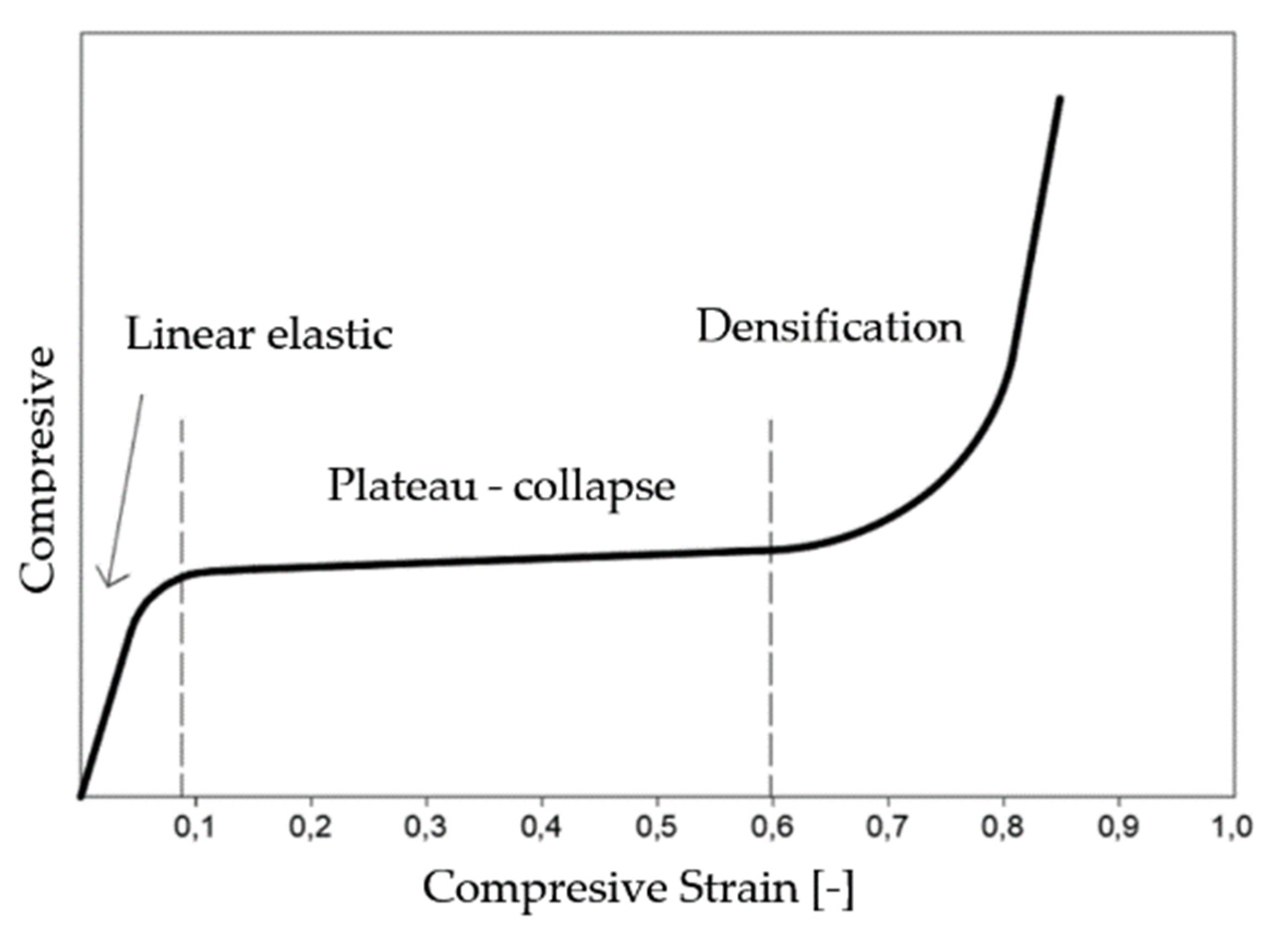
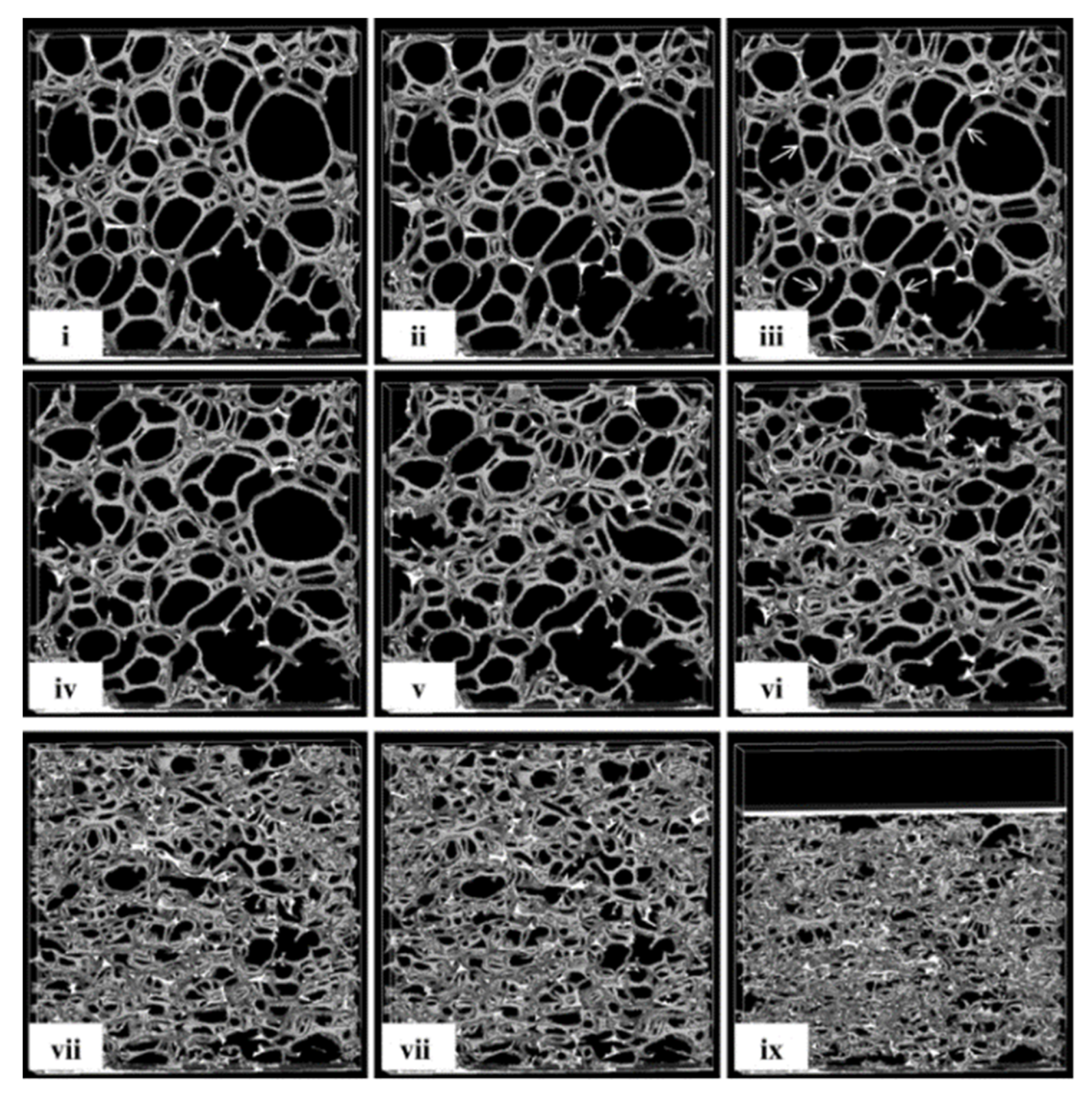

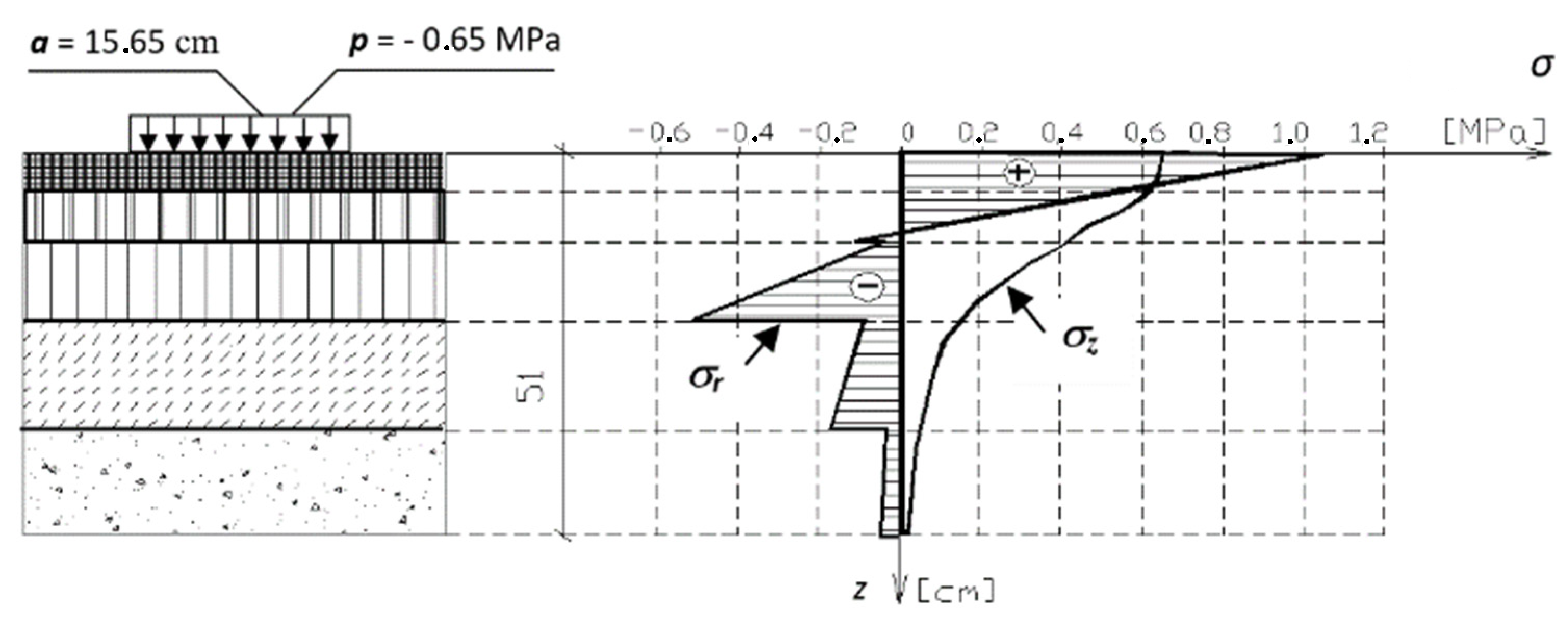

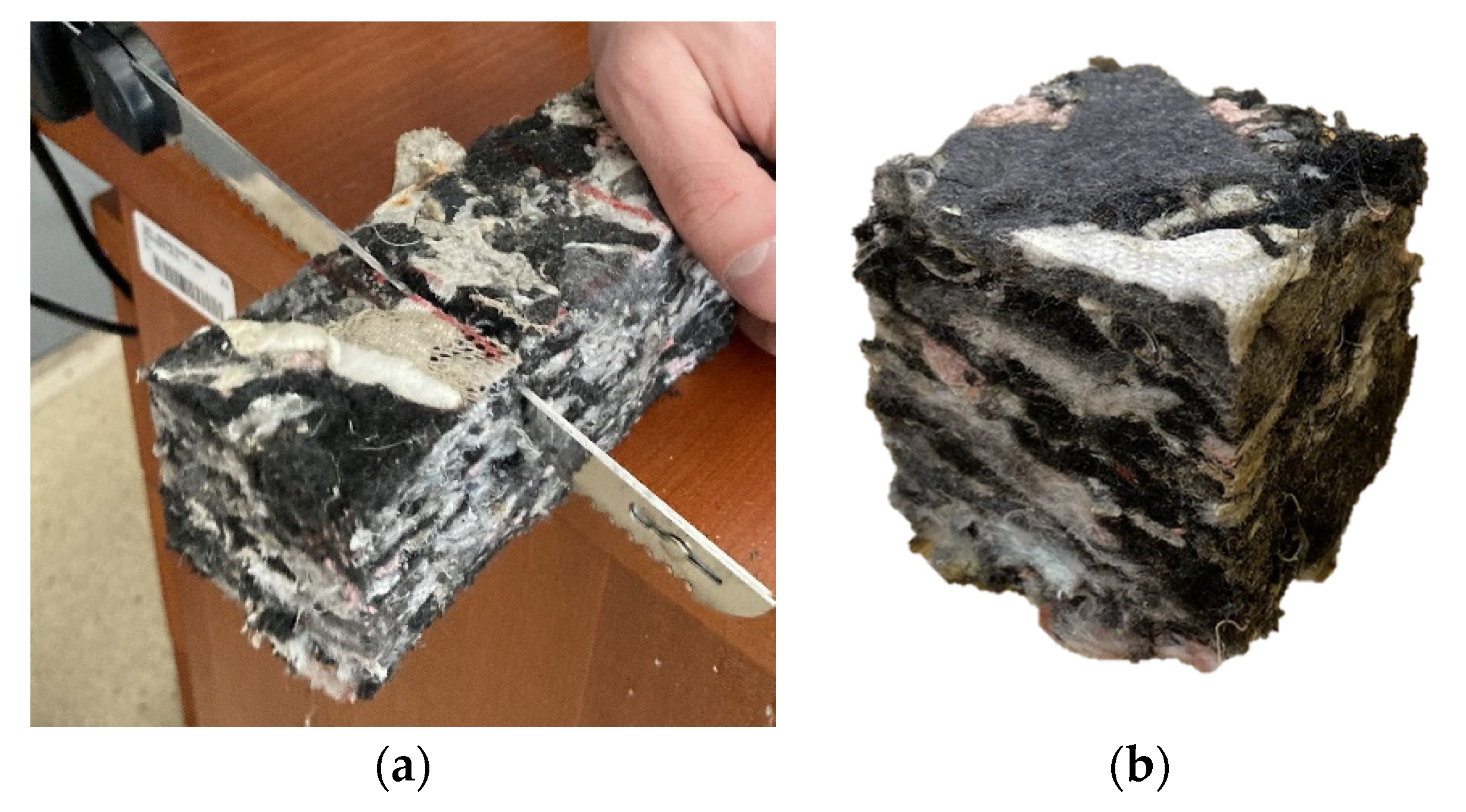
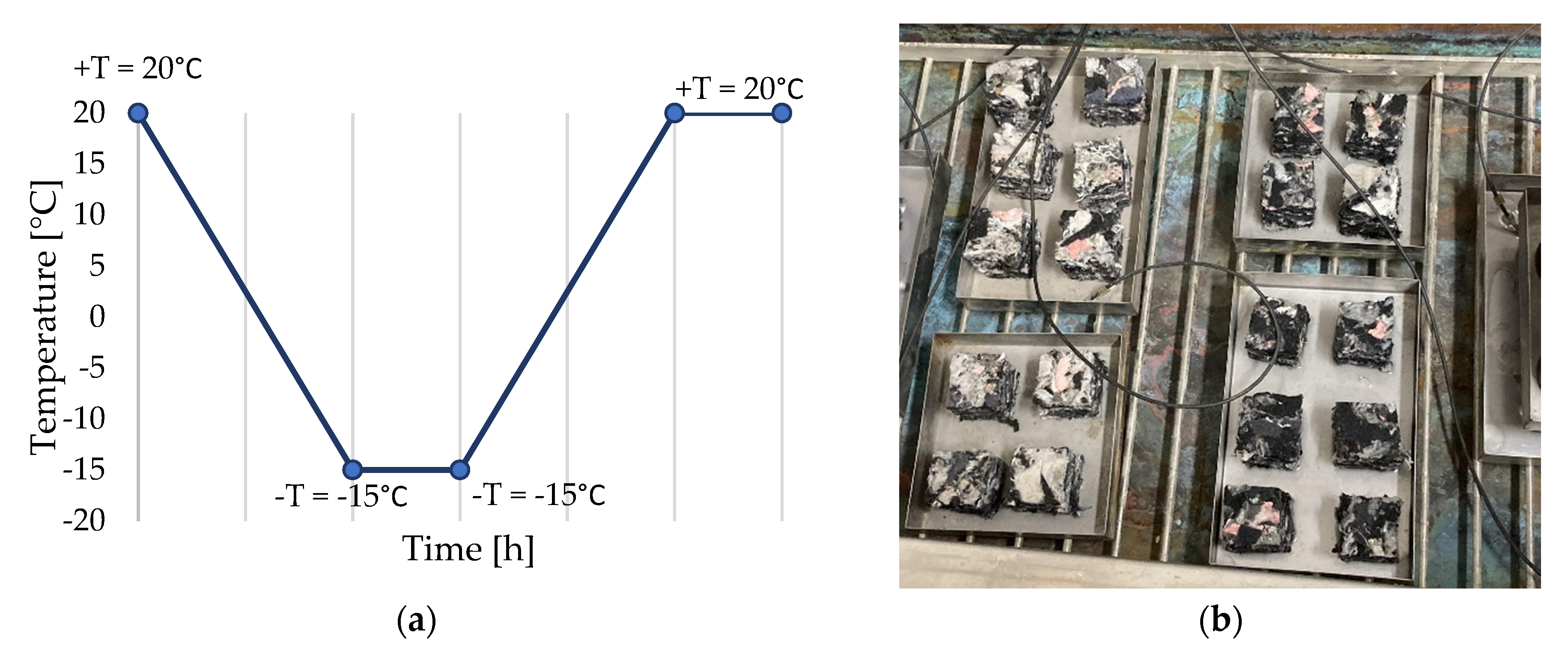


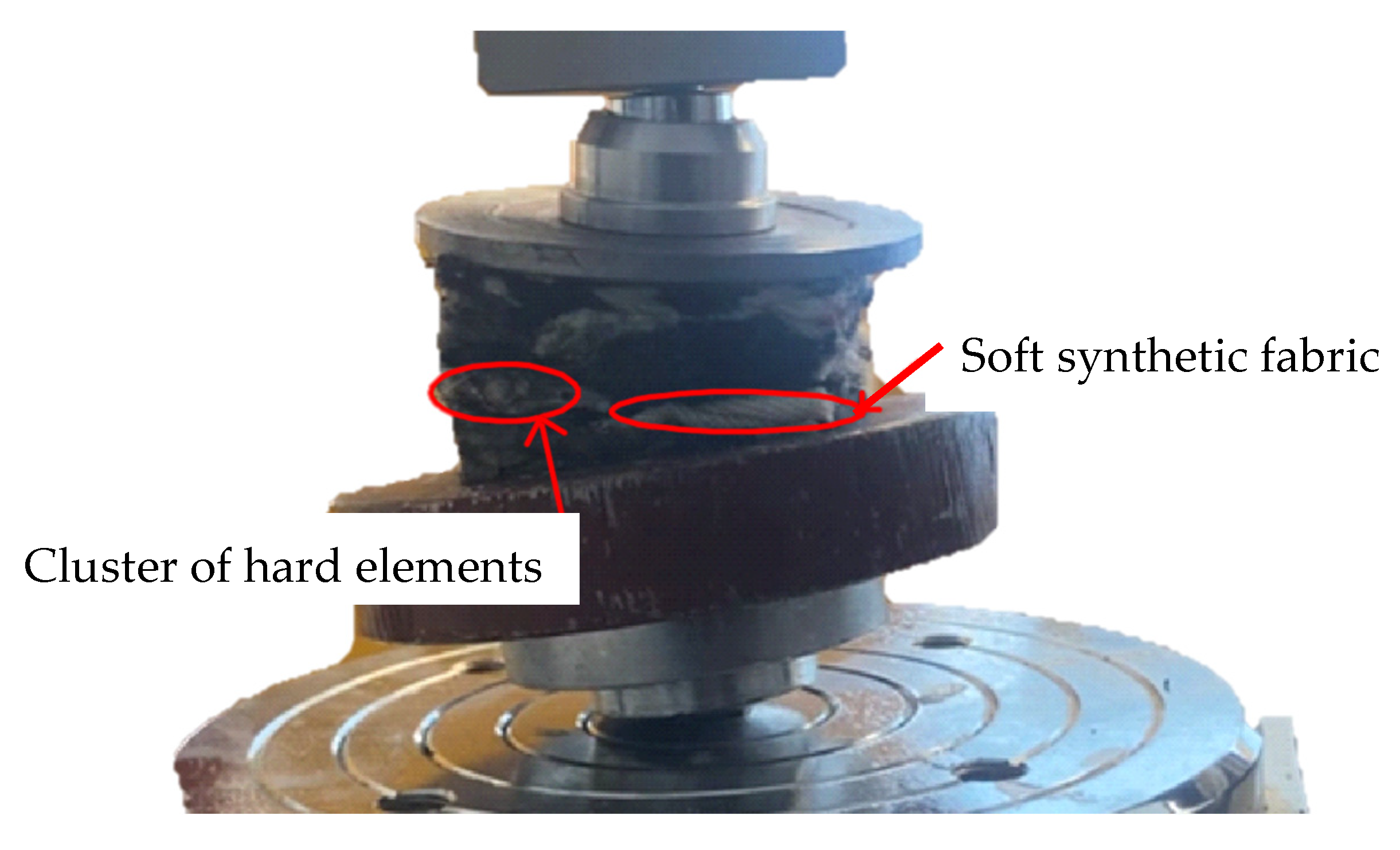


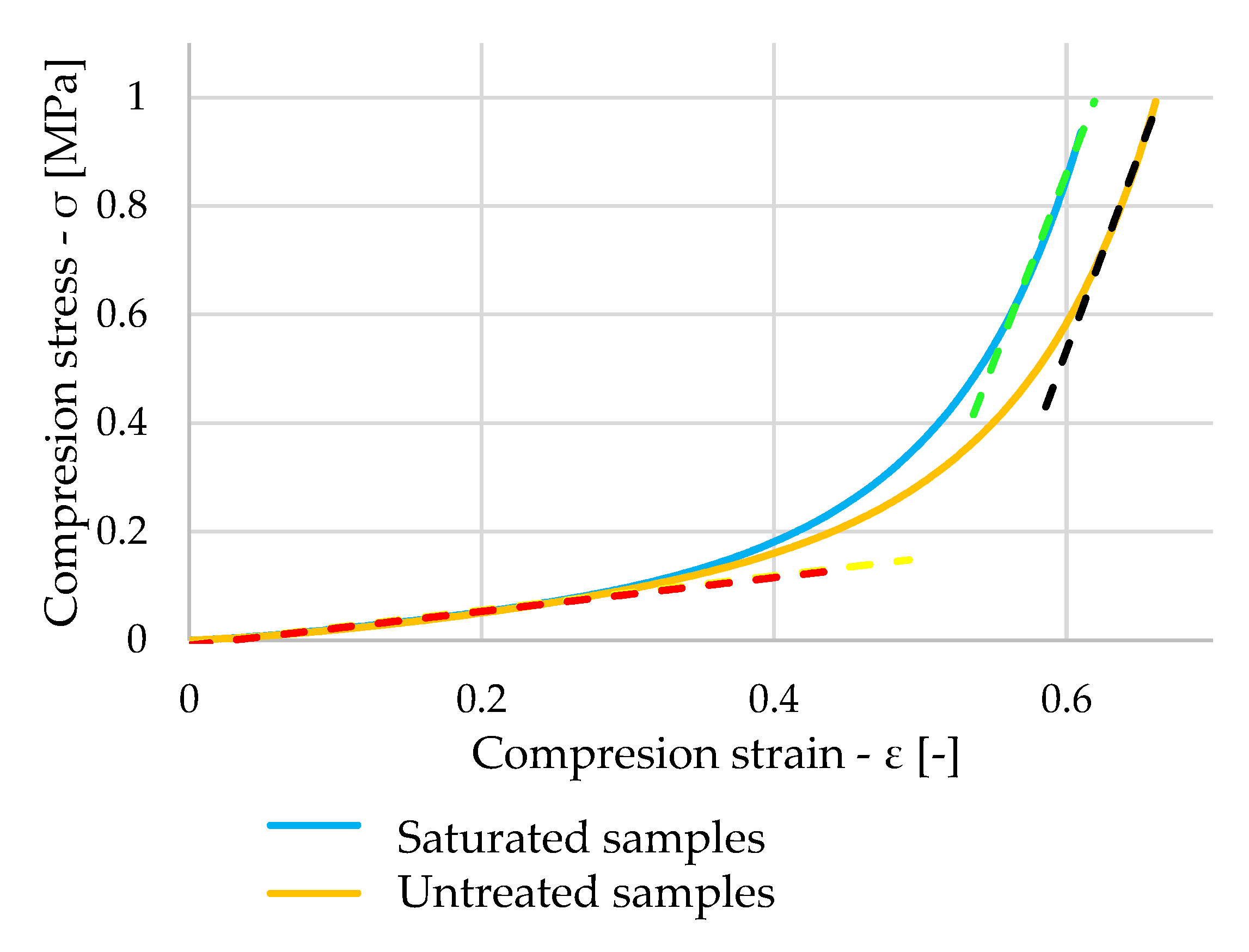


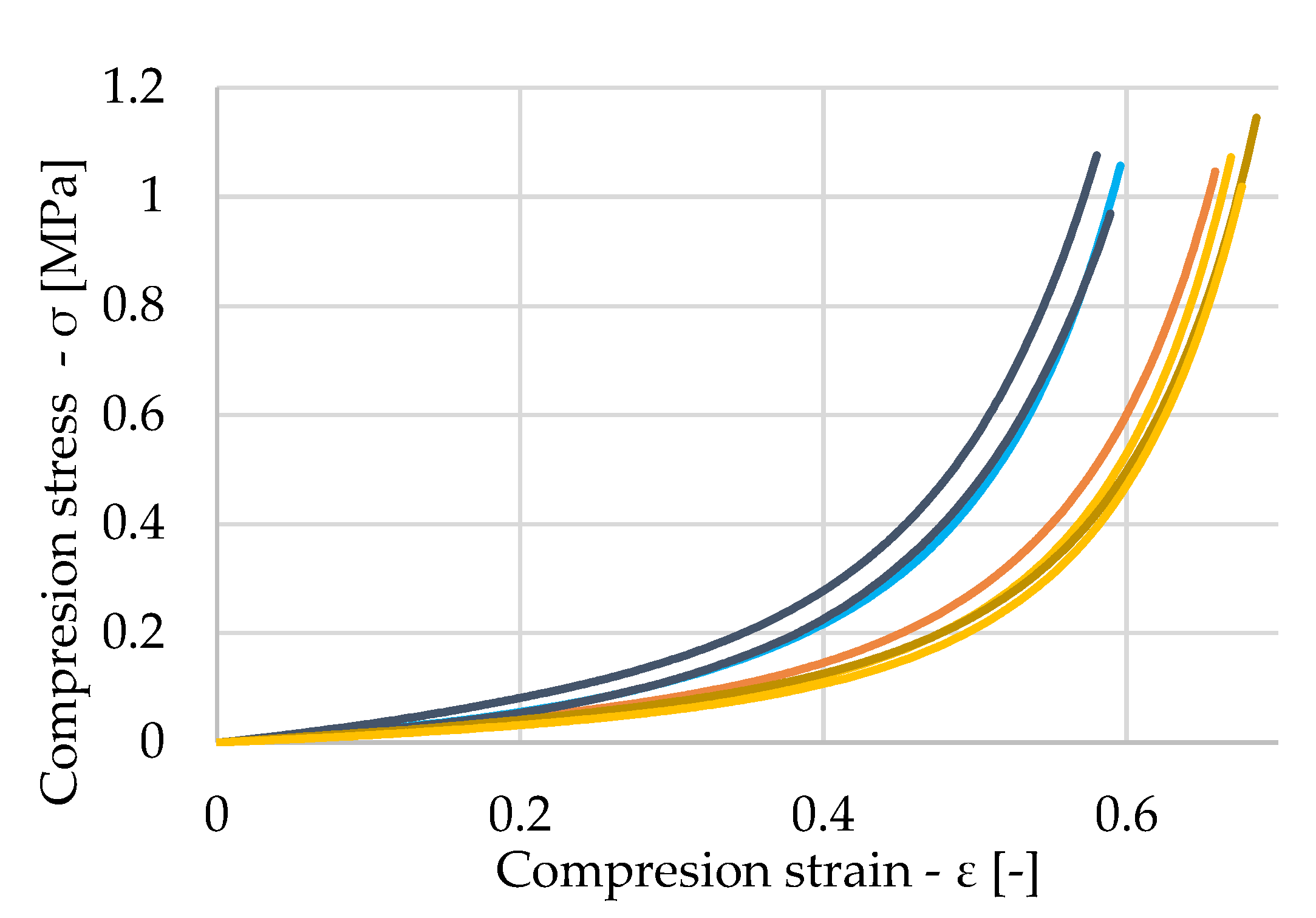
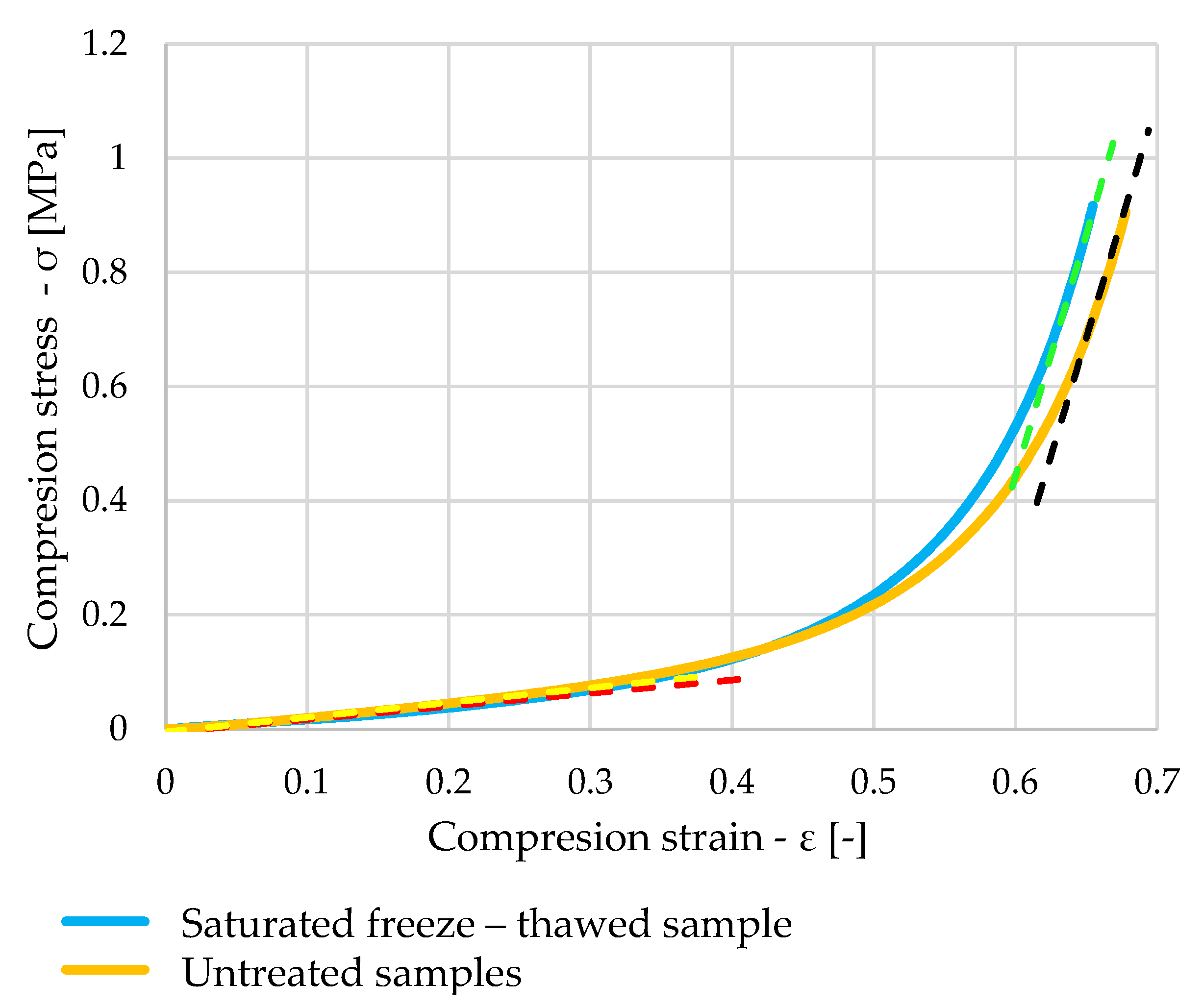

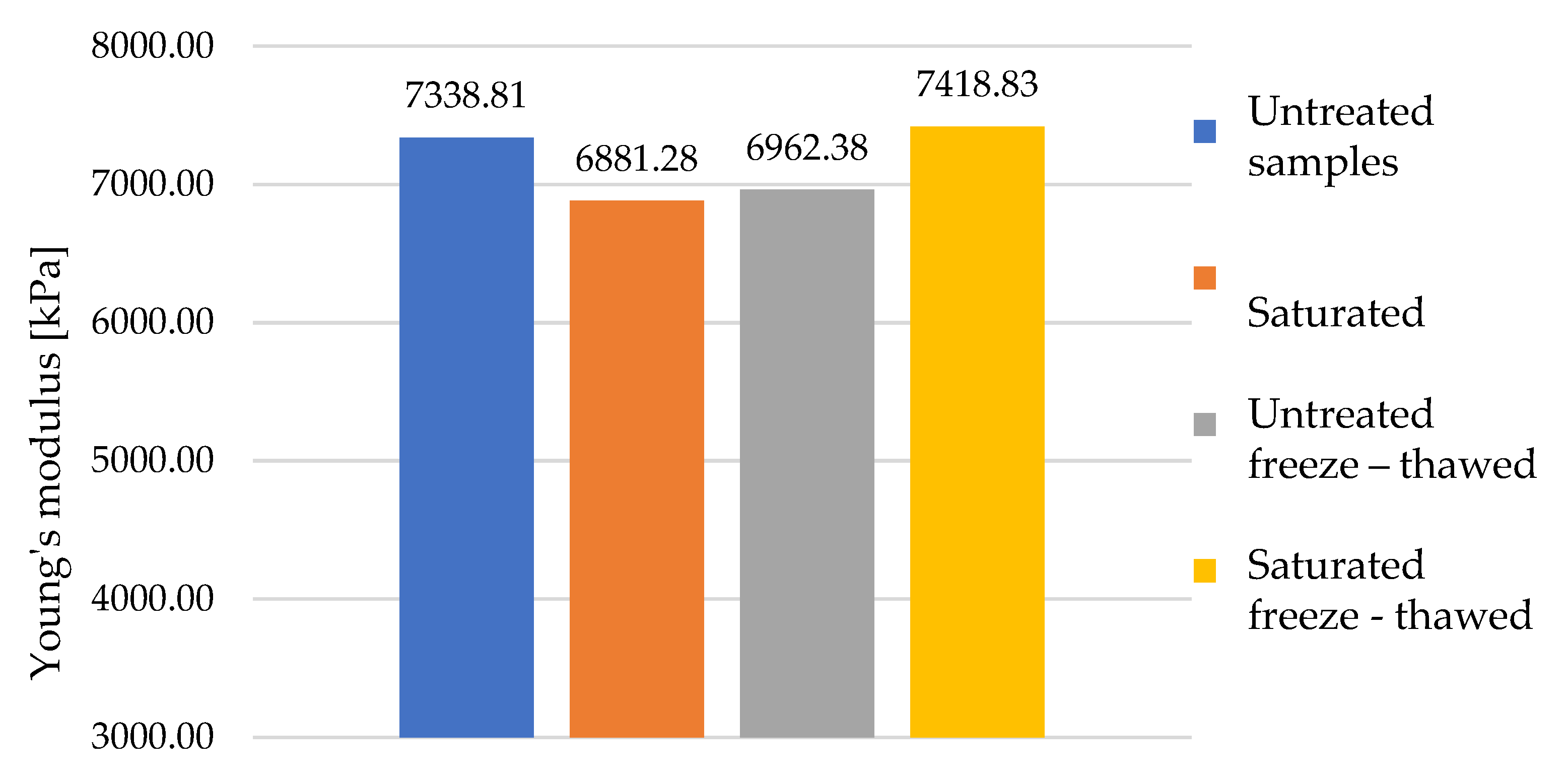
| Sample Group | Label of Sample | Height [mm] | Dimensions Width/Length/Height [mm] |
|---|---|---|---|
| 0.—untreated | 230214-0-01 | 55.8/57.3/57.6/57.5 | 48.1/47.3/57.05 |
| 230214-0-02 | 55.8/55.0/56.1/56.3 | 51.5/54.9/55.80 | |
| 230214-0-03 | 50.5/47.9/48.8/50.9 | 54.6/52.1/49.53 | |
| 1.—fully saturated | 230228-1-01 | 60.0/58.4/58.6/58.5 | 51.4/49.8/58.88 |
| 230228-1-01 | 56.4/55.1/55.9/52.3 | 49.2/49.7/54.93 | |
| 230228-1-03 | 58.4/56.2/57.1/54.9 | 51.2/50.3/56.65 | |
| 2.—freeze–thawed untreated | 230413-2-01 | 56.8/56.2/55.9/56.4 | 48.7/50.5/56.33 |
| 230413-2-02 | 56.8/57.4/56.2/57.0 | 53.7/51.2/56.85 | |
| 230413-2-03 | 58.7/58.2/58.2/57.8 | 52.1/49.6/58.23 | |
| 3.—freeze–thawed fully saturated | 230413-3-01 | 50.6/51.8/51.4/53.4 | 49.8/52.3/51.80 |
| 230413-3-02 | 50.2/50.4/50.9/50.7 | 47.8/49.1/50.55 | |
| 230413-3-03 | 49.7/50.4/49.9/50.6 | 47.5/49.8/50.15 |
| Sample Label | Young’s Modulus—Plateau Collapse [kPa] | Youngs Modulus—Densification [kPa] |
|---|---|---|
| 0_07 | 258.8 | 7539.3 |
| 0_10 | 293.9 | 7164.5 |
| 0_14 | 257 | 8275.7 |
| 0_16 | 284.9 | 7743.9 |
| 0_18 | 268.2 | 7009.1 |
| 0_05 | 372.3 | 8766.4 |
| 0_12 | 360.3 | 8020.8 |
| 0_17 | 382.9 | 7463.2 |
| 0_19 | 388.1 | 6376.4 |
| Sample Label | Weight before | Weight after | Weight after |
|---|---|---|---|
| Saturation [g] | Saturation [g] | Compression [g] | |
| 1_01 | 34 | 154 | 86 |
| 1_02 | 31 | 131 | 59 |
| 1_03 | 34 | 149 | 79 |
| 1_04 | 25 | 146 | 73 |
| 1_05 | 30 | 139 | 72 |
| 1_06 | 28 | 132 | 66 |
| 1_08 | 29 | 129 | 63 |
| 1_09 | 30 | 148 | 77 |
| 1_10 | 26 | 141 | 78 |
| Sample Label | Young’s Modulus—Plateau Collapse [kPa] | Youngs Modulus—Densification [kPa] |
|---|---|---|
| 1_02 | 241 | 8114.2 |
| 1_04 | 213.4 | 7099.5 |
| 1_08 | 228.6 | 6966.9 |
| 1_09 | 209.1 | 6953.8 |
| 1_01 | 430.4 | 6451.2 |
| 1_03 | 331.5 | 5971.5 |
| 1_05 | 343.5 | 6458 |
| 1_06 | 316.8 | 6987.1 |
| 1_10 | 359.6 | 6929.4 |
| Sample Label | Young’s Modulus—Plateau Collapse [kPa] | Youngs Modulus—Densification [kPa] |
|---|---|---|
| 2_04 | 405.4 | 7417.5 |
| 2_05 | 367.8 | 5870.1 |
| 2_09 | 385.2 | 6524.8 |
| 2_02 | 404.1 | 6943.6 |
| 2_01 | 545.1 | 7099.3 |
| 2_07 | 510.3 | 7131.5 |
| Sample Label | Weight before Saturation [g] | Weight before Freeze–Thaw Cycles [g] | Weight after Freeze–Thaw Cycles [g] |
|---|---|---|---|
| 3_01 | 31 | 138 | 86 |
| 3_02 | 28 | 144 | 69 |
| 3_03 | 27 | 139 | 61 |
| 3_04 | 34 | 127 | 79 |
| 3_05 | 30 | 145 | 63 |
| 3_06 | 34 | 129 | 38 |
| 3_07 | 31 | 146 | 66 |
| 3_08 | 34 | 130 | 63 |
| 3_09 | 25 | 141 | 75 |
| 3_10 | 30 | 152 | 80 |
| Sample Label | Young’s Modulus—Plateau Collapse [kPa] | Youngs Modulus—Densification [kPa] |
|---|---|---|
| 3_04 | 265.2 | 7357.3 |
| 3_06 | 229.8 | 8462 |
| 3_09 | 238.3 | 8131.4 |
| 3_10 | 192.7 | 7098.9 |
| 3_01 | 346.2 | 7506.2 |
| 3_07 | 346.6 | 6660.1 |
| 3_08 | 462.1 | 7759 |
Disclaimer/Publisher’s Note: The statements, opinions and data contained in all publications are solely those of the individual author(s) and contributor(s) and not of MDPI and/or the editor(s). MDPI and/or the editor(s) disclaim responsibility for any injury to people or property resulting from any ideas, methods, instructions or products referred to in the content. |
© 2024 by the authors. Licensee MDPI, Basel, Switzerland. This article is an open access article distributed under the terms and conditions of the Creative Commons Attribution (CC BY) license (https://creativecommons.org/licenses/by/4.0/).
Share and Cite
Papán, D.; Decký, M.; Ďugel, D.; Durčák, F. Identification of Hybrid Polymer Material STERED and Basic Material Properties Used in Road Substructures or Pavements. Polymers 2024, 16, 663. https://doi.org/10.3390/polym16050663
Papán D, Decký M, Ďugel D, Durčák F. Identification of Hybrid Polymer Material STERED and Basic Material Properties Used in Road Substructures or Pavements. Polymers. 2024; 16(5):663. https://doi.org/10.3390/polym16050663
Chicago/Turabian StylePapán, Daniel, Martin Decký, Daniel Ďugel, and Filip Durčák. 2024. "Identification of Hybrid Polymer Material STERED and Basic Material Properties Used in Road Substructures or Pavements" Polymers 16, no. 5: 663. https://doi.org/10.3390/polym16050663





